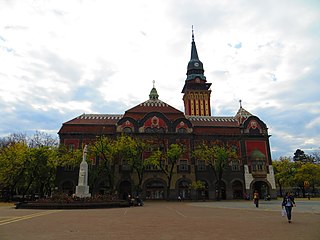
Subotica is a city and the administrative center of the North Bačka District in the autonomous province of Vojvodina, Serbia. Formerly the largest city of Vojvodina region, contemporary Subotica is now the second largest city in the province, following the city of Novi Sad. According to the 2022 census, the urban area of the city has a population of 94,228, and the population of metro area stands at 123,952 people.

Moorish Revival or Neo-Moorish is one of the exotic revival architectural styles that were adopted by architects of Europe and the Americas in the wake of Romanticist Orientalism. It reached the height of its popularity after the mid-19th century, part of a widening vocabulary of articulated decorative ornament drawn from historical sources beyond familiar classical and Gothic modes. Neo-Moorish architecture drew on elements from classic Moorish architecture and, as a result, from the wider Islamic architecture.

Lipót Baumhorn was a Hungarian architect of Jewish heritage, the most influential Hungarian synagogue architect in the first half of the 20th century. He drew blueprints for about 20 synagogues in the Kingdom of Hungary.

The history of the Jews in Serbia is some two thousand years old. The Jews first arrived in the region during Roman times. The Jewish communities of the Balkans remained small until the late 15th century, when Jews fleeing the Spanish and Portuguese Inquisitions found refuge in the Ottoman-ruled areas, including Serbia.
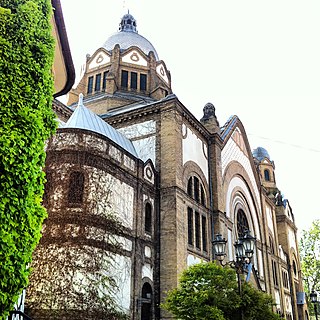
The Novi Sad Synagogue is a former Neolog Jewish congregation and synagogue, located on Jevrejska (Jewish) Street, in the city center of Novi Sad, in the province of Vojvodina, Serbia. Completed in 1909, the building was used as a synagogue until c. 1966; and subsequently used as cultural center since 2012. During its use, with a capacity of 900 worshipers, the synagogue was one of the largest synagogues in Central Europe.

The Dohány Street Synagogue, also known as the Great Synagogue or Tabakgasse Synagogue, is a Neolog Jewish congregation and synagogue, located on Dohány Street in Erzsébetváros of Budapest, Hungary. It is the largest synagogue in Europe, seating 3,000 people, and is a centre of Neolog Judaism. The congregation worships in the Ashkenazi rite.

The architecture of Serbia has a long, rich and diverse history. Some of the major European style from Roman to Postmodern are demonstrated, including renowned examples of Raška, Serbo-Byzantine with its revival, Morava, Baroque, Classical and Modern architecture, with prime examples in Brutalism and Streamline Moderne.
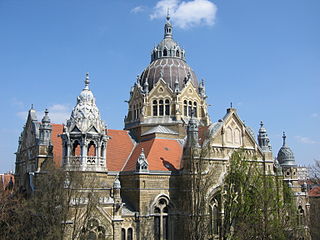
The Szeged Synagogue, also called the Great Synagogue and the New Synagogue, is a Neolog Jewish congregation and synagogue, located at Josika ut. 10, in Szeged, in the county of Csongrád-Csanád, Hungary.

The Cetate Synagogue is a Neolog Jewish congregation and synagogue, located on Mărășești Street in the Cetate district of Timișoara, in Timiș County, Romania. Designed by Carl Schumann in an eclectic architectural style, the synagogue was completed in 1865.

The New Synagogue, sometimes referred to as the Neological Synagogue or Neolog Synagogue, is a former Neolog Jewish congregation and synagogue, located in Žilina, Slovakia.

The Nitra Synagogue is a former Neolog Jewish congregation and synagogue, located at 3 Pri synagóge Street, in Nitra, in the Nitra Region of Slovakia. The building operated as a place of worship between 1911 and World War II; and, since 2004, has operated as a cultural center.
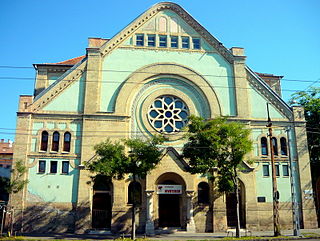
The Dózsa György Street Synagogue, or Angyalföld Synagogue, is a former Orthodox Jewish synagogue located on Dózsa György Street, in Újlipótváros, in the XIII District of Budapest, in Hungary. Completed as a synagogue in 1909, used as a concentration camp during World War II, and subsequently for profaned use, the building was repurposed in 1984 as an indoor sports center by the Budapest Honvéd Sports Association as a fencing hall.

The Páva Street Synagogue is a former Neolog Jewish congregation and synagogue, located at Páva u. 39 in Budapest, Hungary. Completed in 1924, the building was used a synagogue until World War II. The building was extensively renovated from 1999 and was repurposed to house the Holocaust Memorial Center since 2004.

The Debrecen Neological Synagogue is a former Neolog Jewish synagogue that was located on Deák Ferenc Street in Debrecen, Hungary. Completed in 1896, the building was used a synagogue until World War II. After damage during the war, restoration began in 1949; however the building was demolished in the 1960s following a fire.
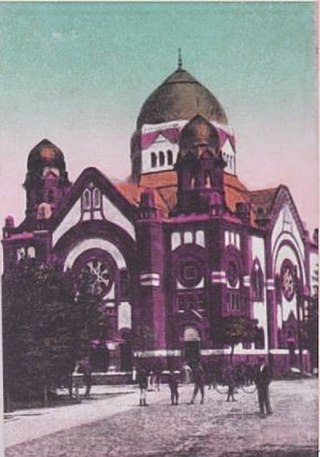
The Makó Neological Synagogue is a former Neolog Jewish congregation and large synagogue, that was located in the town of Makó, in the county of Csongrád-Csanád, Hungary. Completed in 1914, the synagogue was demolished in 1965.

The Nyíregyháza Synagogue, or Nyíregyháza New Synagogue, is an Orthodox Jewish congregation and synagogue, located in the town of Nyíregyháza, in the Great Hungarian Plains region, in the county of Szabolcs-Szatmár-Bereg, Hungary. The building was completed in 1932. The congregation was founded by Neolog Jews in 1865, who worshipped in the Ashkenazi rite. The congregation later merged to form an Orthodox community who ceased worshipping in the Ashkenazi tradition after World War II.
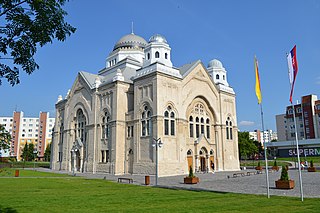
The Lučenec Synagogue is a former Neolog congregation and synagogue, located in Lučenec, in the Banská Bystrica region of Slovakia. Completed in 1925 in the Secession style and is registered as a National Cultural Monument, the building was used as a synagogue until World War II. It was reconstructed and reopened as a cultural center on 13 May 2016.

The Gyöngyös Synagogue, also called the Great New Synagogue, is a former Neolog Jewish synagogue, located in Gyöngyös, Hungary. Completed in 1930, the building was used a synagogue until World War II, subsequently for profane use, and in 2014 it was announced that the former synagogue would be transformed into a cultural center.
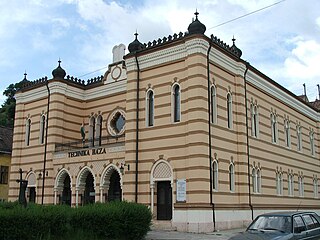
The Esztergom Synagogue is a former Jewish congregation and synagogue, located in the town of Esztergom, Hungary. The synagogue was built in 1859, renovated in 1888, and severely damaged by a bombing during World War II. Since almost all Jewish people in the town were deported during the Holocaust and Communists subsequently gained control of the country, the building has not been used for religious purposes since the 1940s.
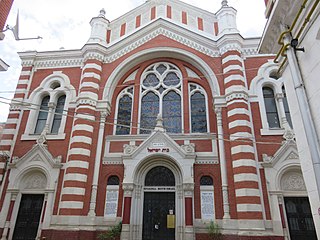
The Brașov Synagogue, officially the Beth Israel Synagogue in Brașov is a Neolog Jewish congregation and synagogue, located at 29 Poarta Șchei Street in the center of Brașov, in Transylvania, Romania. Designed by Lipót Baumhorn in the Hungarian Secession style, the synagogue was completed in 1901, and is situated behind the street front, on a plot surrounded by houses. The synagogue plays a ritual role and the building complex includes a community seat and a kosher restaurant.





















